Table of Contents
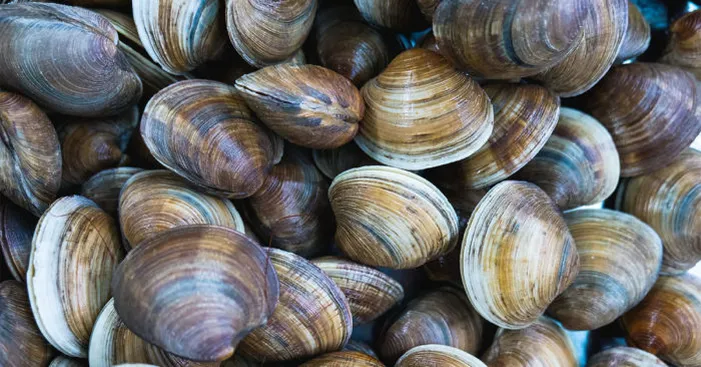
Little neck clams have fine and delicate flesh which gives you the real taste of fresh seafood.
No wonder why these little clams are on the menu of almost every Mediterranean and Atlantic restaurant.
Some people like to eat them raw while others prefer to consume them cooked but either way, its delicacy is a blessing.
In this article, we gathered all the information you need to learn about little neck clams including their nutritional value, health benefits, and possible side effects, with some tips on how to buy+cook+store them.
What are the little neck clams?
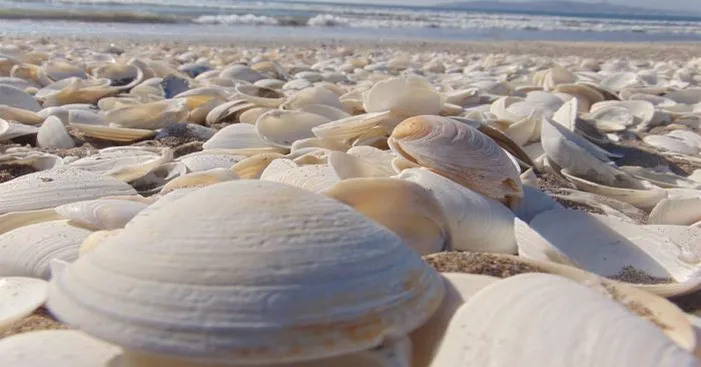
Little neck clams are among the bivalve mollusk group which includes oysters, scallops, and mussels.
This group usually refers to seafood creatures that have hard two-part shells that protect an internal soft body.
In addition, these shelled creatures live buried under marine sediments feeding on small organisms that get filtrated through their system.
Little neck clams also known as the “pacific little neck clams” live on the West-coastal line of the USA and Canada.
Generally, these clams live at the depth of up to 320ft (100m) and they are omnivores feeding on small organisms like algae and plankton.
As for their shells, little neck clams have a striped shell that varies in color from grayish-white to yellowish-white.
In the market, little neck clams are considered classy seafood and sold at higher prices than oysters and shellfish.
Little neck clams nutritional values and health benefits:
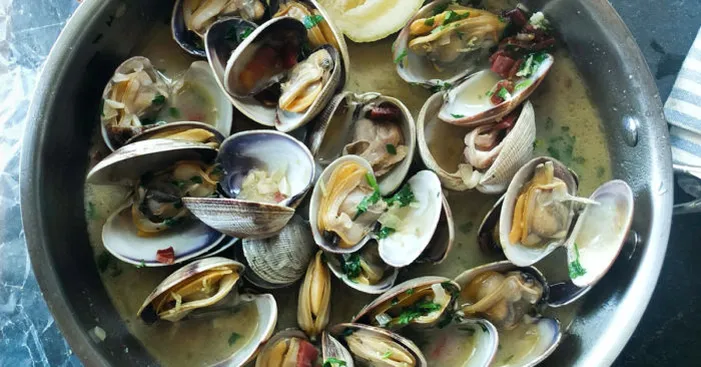
Nutritional data of little neck clams:
The daily serving of little neck clams is about 1 cup which is around 12 medium clams (100g).
This amount offers 120 calories and more than 25g of protein which can cover 25% of the daily needs of an average person.
These small sea fruits are full of Iron with 4 times more Iron than liver for the same portion size.
Aside from iron, these clams also offer good amounts of Selenium, manganese, phosphorus, and copper.
In addition, little neck clams are also a good source of vitamins especially A, C, B2, and B12.
This data count for a serving of 3.5oz (12 clams or 100g) of cooked little neck clams:
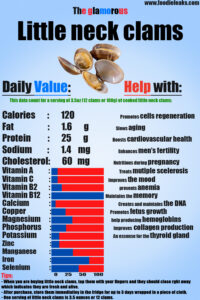
- Calories: 120
- Fat: 1.6g
- Protein: 22g
- Sodium: 1.4mg
- Cholesterol: 60mg
- A vitamin: 12%
- C vitamin: 12%
- B2 vitamin: 20%
- B3 vitamin: 14.5%
- B12 vitamin: 1250%
- Calcium: 8%
- Copper: 27%
- Magnesium: 40%
- Phosphorus: 28%
- Potassium : 15%
- Zinc: 15%
- Manganese: 41%
- Iron: 72%
- Selenium : 52%
Little neck clams health benefits:
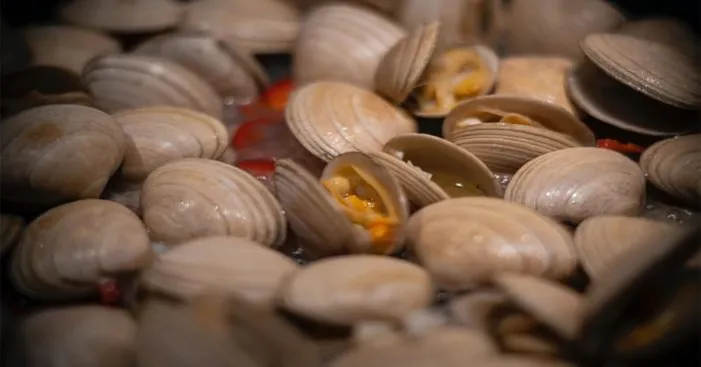
Nutritious for pregnancy:
These clams can be a great source of nutrients to benefit both the mother and the fetus during pregnancy.
These clams contain iodine, an essential element for the proper functioning of the thyroid gland and the development of the fetus.
As mentioned above, this type of clam offers good amounts of minerals and vitamins especially B12 which is crucial for the fetus’s growth.
However, since clams are part of the filtering system of the marine life they could get contaminated which we will explain later on.
In that sense, it is very important for a pregnant woman to only consume well-cleaned little neck clams bought from trusted sources.
Stimulates the production of collagen:
Collagen is a type of protein that the body produces but to do that it needs certain nutrients to do so.
It is very common that people don’t create enough collagen even though it is very important for the well-being of our health.
In fact, collagen is essential to maintain skin elasticity, body tissues, and mucous membranes.
Among the ways someone could improve the production of collagen is by taking more vitamin C supplements.
This is where the little neck clams come in handy as it offers a good boost to reach the daily requirement for vitamin C.
Full of vitamin B12:
As you saw above, yes that was not a mistake!
Little neck clams offer more than 1000% of vitamin B12 per serving which will ensure that you reach your daily needs.
With B12, there is no risk of overdose as our body takes as much as it needs and the rest is expelled through urine.
With that much B12 content, these clams are a better source than beef and certainly on the top 5 list of the highest sources of vitamin B12.
Once we supply the body with its needs in this nutrient, it uses it to synthesize protein, and create DNA and hemoglobin.
In addition, the brain uses vitamin B12 to slow down the aging of its cells, therefore maintaining memory and energy.
Some doctors prescribe vitamin B12 as part of a treatment for Multiple Sclerosis and macular degeneration.
Increases male fertility:
Selenium and Zinc are two important minerals for men as they play a key role in the production of sperm.
With 15% of Zinc and 50% of Selenium per serving of little neck clams, they can certainly improve a male’s fertility and the quality of the sperm.
When a man consumes clams, his body uses those trace elements to produce testosterone which improves the quality of sperm and their mobility.
It also favors the production of good sperms and reduces the production of deformed sperms.
Offers a lot of Iron:
In the United States, there are an estimated 10 million people suffer from an iron deficiency.
Iron is among the minerals that our bodies need on a daily basis to carry on crucial body functions.
For instance, iron helps transport oxygen, prevent the risk of anemia, and create certain hormones.
With a daily serving of little neck clams (12 clams), we get more than 70% of our daily needs in Iron.
Maintains a healthy thyroid gland:
Since little neck clams offer a good amount of Iodine (more than 50%), consuming them helps us reach our daily needs.
Iodine must be taken externally as the body doesn’t produce it and it plays an essential role in the production of thyroid gland hormones.
A deficiency in iodine can result in hypothyroidism and under-development of the brain of kids whose mothers had iodine deficiency during pregnancy.
A good source of protein:
Protein is essential as every cell of our body needs it to repair damages and regenerate.
Especially teenagers and children need to meet their daily protein requirement of 0.8g per 1lbs of body weight.
In other words, a serving of little neck clams offers itself more than 20% of the daily needs of protein for a person weighing 165 pounds.
The basic components of protein are amino acids and they can be put into categories:
- Essential amino acids: These amino acids must be consumed externally as the body can’t create them.
- Non-essential amino acids: self-made by the body from essential amino acids after it breaks down protein.
- Conditional amino-acids:
- Required mostly during periods of sickness and stress.
The good thing about little neck clams is that they offer a full protein which means it has all of the 9 essential amino acids.
Consuming little neck clams:

This variety of clams can be cooked in a bunch of stews, soups, broths, and many other dishes.
Think of the usage of chicken meat, you can use it with almost anything broths, soups, couscous, spaghetti, rice…
Little neck clams may be different than chicken in terms of taste, quality, and cooking time… but almost the same usage.
However, since the meat of clams is very delicate it should not be cooked with a lot of spices otherwise its flavor is gone.
The usage of clams can differ based on the size:
- Small little neck clams: steamed or raw.
- Medium little neck clams: stuffed then grilled.
- Large little neck clams: simmered in soups broths.
For instance, Americans like to consume little neck clams with chowder soup, a cream-based soup with potatoes.
As for Italians, they have their famous “alle yongole”, spaghetti with clams.
Being the world’s top consumers of seafood, the Japanese consume little neck clams in Fukagawa-meshi (rice with clams) or different soups.
In addition, the larger little neck clams can be stuffed with garlic and parsley topped with breadcrumbs, and broiled for 5 minutes.
Cooking tips:
Before cooking little neck clams you need to carefully wash them in the water while brushing the shells to remove impurities (sand, mud…).
In fact, the shell of clams accumulates limestone and algae which may contaminate your broth if you cook them unwashed.
After washing the clams, you need to marinate them in saltwater for at least 30 minutes to further remove any pollutants.
Furthermore, it’s hard to open clamshells but boiling them for 5 minutes makes them easy to unlock.
Cooking ideas:
- With pasta: you can add little neck clams to a pasta sauce whether it’s a tomato sauce or béchamel sauce…
- Stuffed: after boiling these clams for 5 minutes you can easily open them and stuff them with cheese, garlic, chopped vegetables, herbs…
you can finally grill them for 5 minutes and then enjoy them with your family! - In a chowder soup: a very famous American East Coast dish made with potatoes, vegetables, and a creamy broth.
- In a marinade: after boiling the clams or cooking them in the oven, you can marinate them in a mix of olive oil, lemon juice, garlic, hot sauce, and herbs…
Let the clams marinate for 4 hours then drain and serve them as an appetizer or on top of a rice dish or salad.
Recipes with little neck clams:
Little neck clams with almonds:
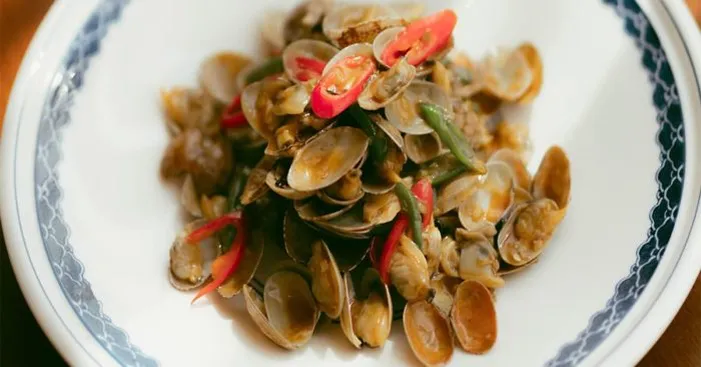
Ingredients:
- 3 lbs. of little neck clams.
- 2 cloves of garlic.
- 1 tbsp. of melted butter.
- 2oz of blended almonds.
- 1 tbsp. of breadcrumbs.
- 1 chopped onion.
- Some chopped parsley.
- Salt and ground pepper.
Preparation:
- Marinate the clams in salted water for about 1 hour then rinse them with cold water
- Boil the clams at medium heat for about 10 minutes to make them easier to open.
- Open each clam and get rid of the upper half of its half.
- Mix melted butter with parsley, garlic, almond powder, onions, and breadcrumbs.
- Put one tbsp. of the mixture on top of each clam, place them on a tray, and cook them in the oven for 15 minutes, enjoy them with your loved ones!
Tuscany soup with bread and little neck clams:

Ingredients:
- 3lbs of little neck clams (36 clams).
- 1 cup of chicken broth.
- 2 chopped tomatoes.
- 5 chopped cloves of garlic.
- 5 slices of white loaf diced.
- 2 tbsp. of olive oil.
- Salt and pepper
Preparation:
- Start by frying the chopped garlic in olive oil then add chopped tomatoes and Sautee them for 5 minutes.
- Now add the diced loaf and the chicken broth.
- Let the mixture cook for 10 minutes on medium heat (300°F, 150°C), take them off the heat, and let the soup cool down before placing it in the fridge for 2 hours.
- Marinate the clams in cold salted water for 1 hour then change the water and boil them for 10 minutes till they are half-cooked and become easy to open.
- Take the soup out of the fridge and put it on serving plates.
- Season the clams with pepper and parsley and place them on top of the soup.
- Add some olive oil on top of each dish and serve it!
Precautions before consuming clams:

Little neck clams and butter:
Most people make is dipping their little neck clams in melted butter which is bad for their health.
Consuming clams in moderate amounts and without butter won’t risk exceeding the daily limits of fats, carbs, and calories.
The nutritional values of butter for just 1 tbsp. offers 102 calories, 7g of saturated fats, 90 mg sodium, and 30mg of cholesterol.
One tablespoon of butter is safe to eat but the problem occurs when consuming more than 1 tbsp.
This is often the case with a melted butter dip, as you could be getting up to ¼ or ½ tbsp. of butter each time you dip a clam.
Nonetheless, if you can’t quit this habit you may just dose your melted butter so that you don’t consume more than 1 tbsp.
Also, you can mix 1 tbsp. of melted butter with your clams in a bowl which will ensure each clam is buttery.
Heavy metals:
Little neck clams may be contaminated with heavy metals such as cadmium, mercury, and arsenic.
These heavy metals can be toxic for humans especially if they accumulate in large quantities.
For instance, an abundance of arsenic in the body increases the risk of developing cancer and the chance of organ failure.
On the other hand, a high explosion of mercury leads to brain damage while cadmium results in kidney failure.
The risk of heavy metals mainly exists because the body is unable to process them or get rid of them rapidly.
Most seafood contamination refers to high heavy metal content since these creatures are often exposed to pollutants.
This is why specialists recommend getting your little neck clams or any seafood from trusted sources.
Allergy:
Some people may experience an allergic reaction when they consume little neck clams.
In fact, studies show that about 3% of the general population worldwide are allergic to shellfish which includes clams.
This allergy usually develops in adulthood and causes symptoms that may be mild compared to crab, shrimp, or oyster allergic symptoms.
Nonetheless, some people may have an allergy to a certain shellfish and tolerate the other types.
Generally, this type of allergy is the result of the natural immune system’s reaction to a protein called tropomyosin.
The symptoms some people may experience after consuming little neck clams can be:
- Vomiting and diarrhea.
- Hives and difficulty swallowing.
- Coughing and difficulties breathing.
- Swelling of the tongue and lips.
- Anaphylactic reaction (requires emergency).
Iron overdose:
Little neck clams are full of Iron which is very beneficial, however, consuming a large amount could lead to an Iron overdose.
When the body receives large quantities of Iron it becomes at a higher risk of diabetes, diarrhea, and liver damage.
In fact, a study made by the University of Maryland suggests that too much Iron increases the risk of Alzheimer’s, cancer, and heart disease.
Nonetheless, these results are still yet to be confirmed with further studies and it should be safe in case of consuming clams moderately.
Storing clams:
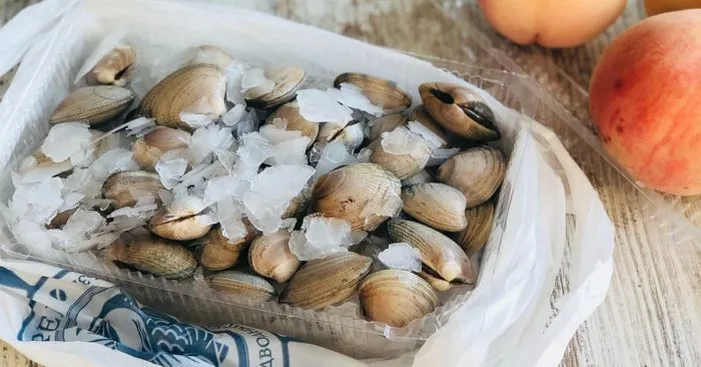
Little neck clams are best eaten on the day of purchase just like most seafood products.
Because of that, they are usually kept alive till the very last moment in aquariums, and sometimes you can even buy them alive.
Nonetheless, once you purchase them you need to store them in the fridge for up to 3 days.
Little neck clams may leak some water and it’s better to have them on the lower part of the refrigerator to avoid contaminating other food.
Also, the recommendation is to wrap them in a piece of cloth instead of airtight containers or bags.
In case you want them to last more, you can always freeze your short neck clams raw not cooked to avoid chewiness.
To freeze these clams, open their shells but freeze them in their own juice and salty water to keep them fresh.
Buying clams:
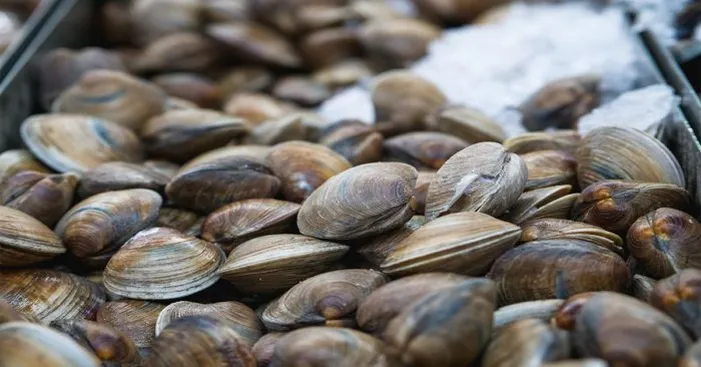
The first thing you need to know open shells or dead clams are already considered spoiled.
When you are buying little neck clams make sure you get them alive which generally means with a closed shell.
Also, if it is slightly open it should close immediately as soon as you tap it with your fingers which confirms the clam is alive.
Now to make the cooking experience better, always try to buy little neck clams of the same size to guarantee an even cooking.
